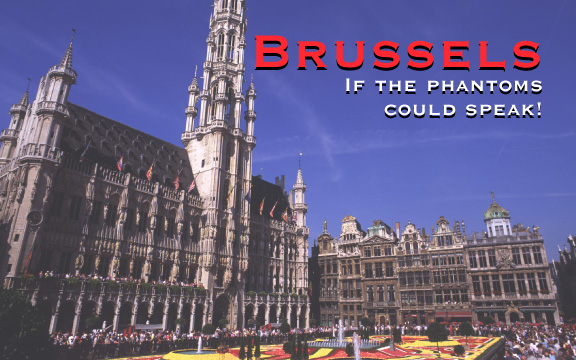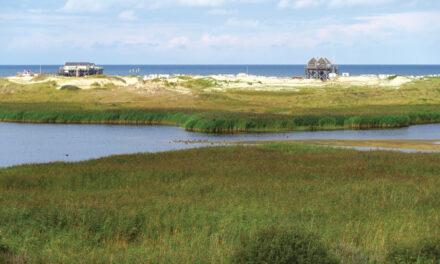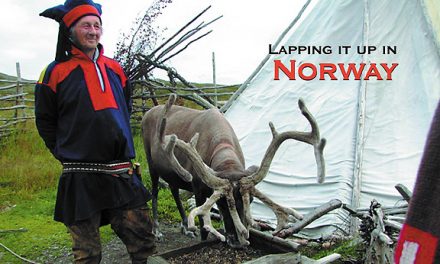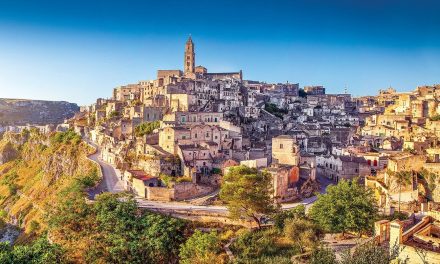Brussels
If the phantoms could speak!
By Lise Giguère
Published in the Spring 2005 Issue of Canadian World Traveller
Photos: Lise Giguère and The Office of Promotion of Tourism in Wallonia-Brussels (www.belgique-tourisme.qc.ca or www.visitbelgium.com)
With a thousand-year-old history, Brussels takes its time in revealing its many charms to the uninitiated visitor. And there is no better introduction to this vibrant capital of Belgium than to spend a leisurely afternoon at one of the many cafés found around its impressive Grand Place. Although considered to be mainly a center of commerce, Brussels has been known to seduce many of its visitors who have chosen to spend even a brief sojourn in the city.
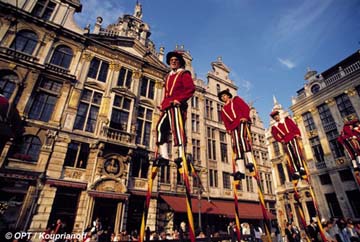 Seated before a tall refreshing glass of Belgian lager or dark ale, crisp golden French fries and a plate of fresh, glistening mussels, you quickly forget everyday cares as your eyes feast on these delectable offerings, made even more so laid out on a sunlit tablecloth. The effect is quite enchanting and equally appetizing.
Seated before a tall refreshing glass of Belgian lager or dark ale, crisp golden French fries and a plate of fresh, glistening mussels, you quickly forget everyday cares as your eyes feast on these delectable offerings, made even more so laid out on a sunlit tablecloth. The effect is quite enchanting and equally appetizing.
After a couple glasses of Belgium’s world-famous beer, it’s easy to believe that one can actually see the phantom of a pensive Victor Hugo, leaning his elbows on the window sill of the residence in which he lived during its exile.
And hold it a minute! Could that be the poets Verlaine and Rimbaud, still in the heat of one of their legendary squabbles? And those dancing shadows; aren’t they the frilly dresses of the beautiful ladies who attended the middle-age tournaments, grandiose festivals and bloody happenings that took place in this very square? Ah, if only these old cobblestones could speak!
La Grand Place
The immense rectangle that is La Grand Place, measuring some 110 metres by 69 metres, is covered in summer with an intricate display of 75,000 begonias that form a huge, colourful outdoor carpet. In the12th century, it was nothing more than a drained marsh. Today, it is the very heart of the old city and the pride of the Brussels’ inhabitants. Dominated by the Town Hall, which was built in the 15th century, La Grand Place also features buildings in the Gothic style, such as the imposing Guild Halls built after the bombardment of the city in 1695 and restored in the 19th century, as well as many statuettes, including those of Saint-Michel.
During the day, La Grand Place teems with locals and tourists who visit, shop, browse or stroll along its terraces. Many are there for the simple pleasure of watching the comings and goings of the affable crowds. In the evenings, spectacular sound and light shows or illuminations of the surrounding historic buildings transform La Grand Place into a magical place. It is said that Cocteau once called this imposing Town Square “the liveliest theatre in the world.”
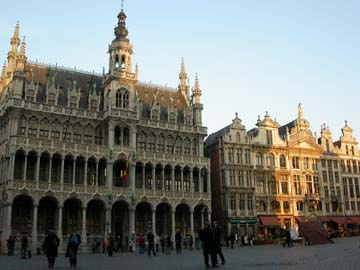 Located a few steps from the square, the Place de Brouckère is a prestigious hotel that offers visitors a unique and unforgettable stay.
Located a few steps from the square, the Place de Brouckère is a prestigious hotel that offers visitors a unique and unforgettable stay.
The nearby Hôtel Métropole is also an excellent choice. A historical listed monument, the décor of this hundred-year-old hotel is a lively mix of the French Renaissance, Romanesque and the early 20th-century styles. Over the decades, celebrities as diverse as Einstein, Jody Foster, Luc Plamondon and General de Gaulle have stayed at the Métropole.
Three Capitals
Because of its geographical position, Belgium was always a meeting-place of diverse cultures and people. This has greatly contributed to its historical, cultural and artistic richness. This relatively small country is considered to be the very nerve centre of Europe, thanks to the many European Union institutions that sit there. The city of Brussels is at the same time, the capital of the European Union, the capital of Flanders and of course, the capital of Belgium.
In this multicultural and polyglot city, home to more than one million inhabitants, one meets people from everywhere in the world, in particular civil servants of the 25 European Union countries. However, for the large majority of the inhabitants of Brussels, French remains the everyday language of use. Although a French-speaking metropolis, many people also speak English as in most other European cities.
For the tourist who really wants to discover and appreciate Brussels, nothing is worth more than a leisurely stroll through its neighbourhoods, taking the time to meet and get to know the Belgians. This is also an occasion to admire its architectural treasures, the heritage of the Belgian dynasty. These include the Royal Palace and Park, the Park of the Fiftieth Anniversary; and the conservatories or other buildings that preserve important stages in the development of the Art Nouveau movement and its leading member, Victor Horta.
Your stroll will also allow you to trace the footsteps and visit the places habituated by such luminaries as Simenon, Jacques Brel, Magritte and Delvaux. But there will also be special moments during your stroll to make new friendships in the markets, shops and small restaurants; to taste the myriad of local beers; to gorge yourself on chocolate; and to yield to the temptation of snacking on fries and the mussels without forgetting the famed gastronomy of Brussels.
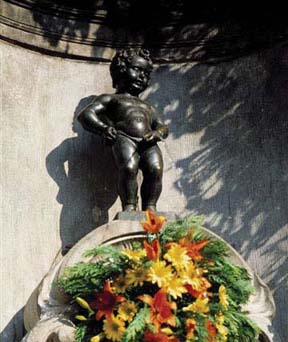
A Bit of Humour
It is impossible to speak about Brussels, without mentioning the warm hospitality and often-naughty repartee of her inhabitants. The Belgians like to laugh and, it should also be noted that they like to bend their elbows as well. “Here, one lives under the influence of beer,” notes one guide book. “Everything changes, depending on how much of it you consume.”
Perhaps this is the explanation of the popularity of the Manneken Pis, a legendary figure that has been showered with honours and distinctions. Many legends exist in connection with this symbol of the spirit of independence of the inhabitants of Brussels, its past rebels, mischief-makers and assorted rogues.
The story goes that, as early as the Middle Ages, there existed a statue bearing the same name. In any event, it is impossible to resist the strong impulse to join the flood of tourists who pay homage to this small bronze fellow, who has been peeing for centuries under the amazed gaze of the tourists. The Manneken Pis fountain is located not far from the Grand Place.
After having paid homage to the statue, why not go on to admire his imposing wardrobe? Oh yes! His over 750 different outfits, one of which transforms him into Elvis, are all on display in the Maison du Roy de la Grand Place!
But the Manneken Pis is not alone in having a museum. There are some 75 other interesting museums in Brussels including the Musée des instruments de Musique (www.mim.fgov.be), displaying musical instruments; the Centre belge de la bande dessinée (www.brusselsbdtour.com), exploring the history of the Belgian comic strip; and the Horta Museum, located in the original private home of this renown architect. His style upset the middle-class of his day, but everyone now admires his sumptuous buildings.
To discover this city and to appreciate all its charms, the Guide & Plan du tout Bruxelles is highly recommended. It offers an overview of Brussels’ markets, shops, museums and monuments as well as suggestions for guided tours. Under the topic Voir et Dire Bruxelles, six knowledgeable associations have compiled daily itineraries based on different themes. These fascinating self-led tours enable visitors to explore aspects of Brussels that interest them, such as the city’s politics, its celebrities, its churches, its art, its past, its comic strips, its beer or its architecture.
Brussels is discovered slowly, but before you know it you will become captivated by its charms! To really appreciate the city, put yourself in its shoes and lose yourself in its streets. The magic unfolds very quickly, and as you bid adieu, you will already be dreaming of your return visit!
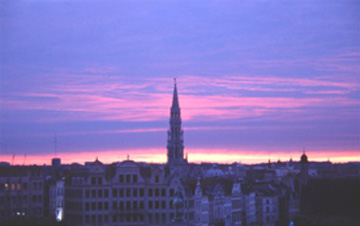 For More Info:
For More Info:
This trip by author Lise Giguère was made possible thanks to the collaboration of the Office of Promotion of Tourism in Wallonia-Brussels (www.belgique-tourisme.qc.ca or www.visitbelgium.com)
Air transportation was provided by Air France (www.airfrance.com/ca) and ground transportation by Thalys (www.thalys.com)

